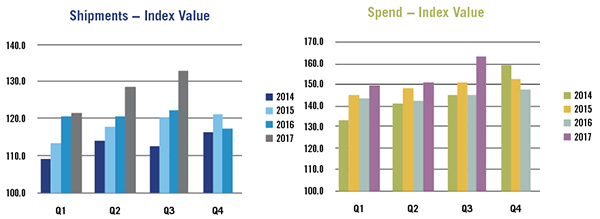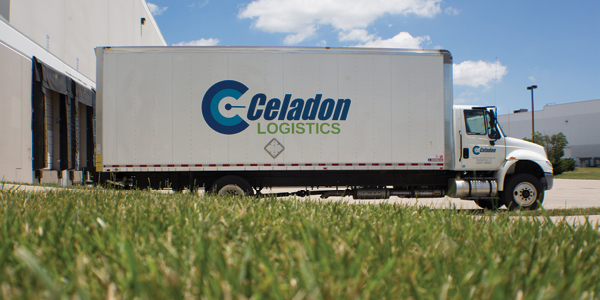Articles
Transportation

How to Navigate the Driver Shortage
The industry’s driver shortage is no secret. About 100,000 seats need to be filled at a time when the pipeline for new drivers is getting thinner. But what’s the practical impact on shippers as this shortage gets worse? In short, it won’t be pretty. Tighter capacity will lead to fewer choices. Regulations mandating the use […]
Read More
Assessing U.S. Shipments and Spend
A tighter truck market, increase in national shipments, and accelerated factory output are among the highlights of the Q3 2017 U.S. Bank Freight Payment Index, which measures quantitative changes in shipment and spend activity (see chart) based on data from transactions the company processes. Highlights include: An 8.3-percent jump in U.S. Bank’s national spend index, […]
Read MoreA Resurgence in Trucking Investments Presents Opportunities for Shippers
Economic indicators and data reports suggest the economy is strengthening, which should continue to promote business confidence through the remainder of 2017. The second quarter 2017 U.S. GDP report indicated that expenditures grew by 3.3 percent, led by an 8.9-percent gain in durable goods spending. With increasing expenditures for durable and non-durable goods, manufacturers, retailers, […]
Read More
Transportation Trends: Turn up the Air
The airfreight market has been flying high, but headwinds persist.
Read More
H.O.W. | How to Manage Your Carrier Relationships After the ELD Mandate
As the mid-December deadline approaches for the implementation of the Electronic Logging Device (ELD) mandate for most commercial truck drivers, shippers are, not surprisingly, worried about how it will affect their supply chain capacity. MORE TO THE STORY: 4 ways to manage capacity post-eld Under Federal Motor Carrier Safety Administration rules, most trucks built after […]
Read More
API Trumps EDI. Here’s Why. – Freightgate
Q: Why invest in an API solution? The transportation industry is changing and it’s changing fast. There are new players in the market like Uber Freight and they have a head start with their digitalization strategy. Offering a cheap and reliable service will not be enough when all of your competitors have moved forward. Many […]
Read More
Supply Chain Commentary: What Shippers Need to Know About Market Tightness
After a two-year slide in transportation prices, the logistics sector is experiencing capacity constraints and historically high and enduring truckload volumes. As we head into peak shipping season, rates have been rising significantly, particularly in the wake of hurricanes Harvey and Irma. Shippers can expect this trend to continue into 2018. The market isn’t likely […]
Read MoreSupply Chain Commentary: Out Darn Spot! Out, I Say!
The comic Steven Wright once joked, “I spilled spot remover all over my dog. Now he’s gone.” For shippers who regularly leverage the spot market, it’s been a buyer’s market the past few years. One shipper I’ve worked with saved more than 9 percent on freight spend simply by moving away from only using brokers […]
Read More
Urban Logistics: You Can’t Fight City Haul
The impact of urbanization—population increases in cities and towns as opposed to rural areas—on business growth and sustainability concerns nearly all companies surveyed in The Road to Sustainable Urban Logistics, a new report by UPS and GreenBiz Group. However, only 47 percent feel prepared to address the associated business challenges, according to the survey. Further, […]
Read More
The Last Mile—History Repeating As Supply Managers Face Peak Season – Crane Worldwide Logistics
Nothing new is ever really created, just updated to meet the current environment or situation. When looking beyond the "hype" of all the new, innovative services and suppliers in the logistics space, we find that delivery service capability has already been efficiently and successfully implemented in the past. We only need to look back to […]
Read More
Hazmat 101: Exceeding Safety and Compliance Standards – Landstar
Hazmat transportation’s multifaceted nature makes logistics particularly complicated, especially when companies don’t realize that they’re transporting such goods. Even though a manufacturer may be an expert at producing goods, it may not be as well-versed in the intricacies of transporting those materials, including unknowingly offering carriers non-compliant hazmat shipments. Compliance is a team effort, and […]
Read More
Smooth Sailings – Wallenius Wilhelmsen Logistics
As reducing damages reduces cost, so too does reducing time.
Read More
Forming an Alliance with Ocean Shipping
After the 2016 Hanjin Shipping bankruptcy, carriers banded together to form alliances. Today, these alliances dominate ocean cargo shipping. Here’s how they affect your shipments and contracts.
Read More
Cargo Security: The Art of the Steal
Keeping your cargo safe from theft is a bigger challenge than you might think. Follow these steps to reduce the risks that make your company a target.
Read MoreFood Transportation: Missing Ingredients to FSMA Compliance
Sanitary transportation compliance is currently mandatory for many and will be required for all shippers, loaders, carriers, and receivers in April 2018. While the FDA Food Safety Modernization Act (FSMA) of 2011 set the guidelines and rulemaking for the Sanitary Transportation of Human and Animal Food (STHAF) in process, there are still gaps in compliance. […]
Read MoreFedEx and UPS Set Aside Rivalry to Lobby White House on Infrastructure
An amusing meme that occasionally makes the rounds on social media shows a FedEx truck parked nose-to-nose with a UPS truck, with the caption "it’s about to go down." For the moment, however, the two major rivals have set aside their differences in the interest of the greater good. David Abney, CEO of UPS and […]
Read More
Supply Chain Education Remains Critical for Compliance with New FDA Sanitary Food Transportation Rule
If there’s one thing that’s crucial to the supply chain, it’s collaboration—and its importance only intensifies during times of change. Signed into law by President Obama in 2011, the U.S. Food and Drug Administration’s Food Safety Modernization Act (FSMA) is “the most sweeping reform to our food safety laws in more than 70 years.” Designed […]
Read More
The Advantages of Strategic Procurement – Schneider Logistics
A sound strategy is important in every industry. It’s even more important than ever when the prevailing theme includes major changes to the regulatory landscape. A driver shortage, competitive rate market, and reduction in productivity will make it more difficult for shippers to secure capacity as we progress into 2018 and beyond. Strategic procurement practices […]
Read MoreHow to Prepare Your Supply Chain for Inclement Weather
Hurricane Harvey and Hurricane Irma both made landfall causing destruction and devastation in their paths. Hurricane Harvey is said to be the biggest hurricane to hit Texas in 50 years and Hurricane Irma is the first major hurricane to hit Florida since Wilma made landfall in 2005. As a result, businesses were forced to shut […]
Read More
The Economy Will Grow. Is That Bad News?
For this annual trucking issue, we surveyed both shippers and carriers on important issues impacting the trucking industry. Most importantly, we solicited their views on the state of the economy as we head into 2018. The good news: not one shipper or carrier responding to our survey thinks that the economy will head south in […]
Read More